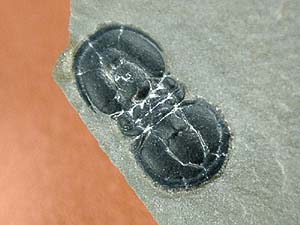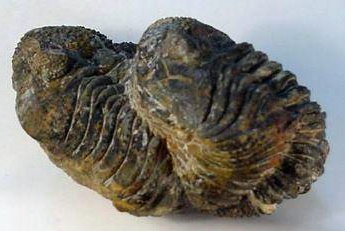"CATCH PHRASES"
**BACKGROUND MUSIC**
"Head Games"
Foreigner
CLICK HERE
"THE BLIND TRILOBITE"
**BACKGROUND MUSIC**
Foreigner

I know of one fossil dealer in particular
who just loves to use this phrase when describing a Peronopsis interstrictus,which
is a very common trilobite of the order Agnostida.No collectors I know have ever called a Peronopsis "THE BLIND TRILOBITE",and it is NOT better known as "THE BLIND TRILOBITE".This phrase makes it sound like you're getting something very special and unusual.You're not.A more accurate description would be to call this "A blind trilobite".The term "THE BLIND TRILOBITE" is very misleading, it makes it sound like Peronopsis interstrictus was the ONLY trilobite that was blind.All Agnostid trilobites of the suborder Agnostina were blind,and most Agnostids of the suborder Eodiscina were blind,as were many other trilobites.Just because a trilobite was blind doesn't mean it's uncommon,or rare, or worth more money,it just means it was blind,and blind Agnostid trilobites aren't unusual at all.Actually just the opposite is true,it's the Agnostids that could see that are unusual.I'm an enthusiastic collector of Agnostid trilobites (not very many of us around!) I have a number of them in my collection,and I find them very interesting,but whenever I see that term "THE BLIND TRILOBITE", I
can only think of one thing to say, SO WHAT!
"BABY TRILOBITES"

I saw an auction one time where a person was selling
an Elrathia kingii and some Peronopsis interstrictus that were together on the same matrix.
They
stated that
this was an adult trilobite and it's babies.
Agnostid triobites such as Peronopsis
interstrictus are NOT "baby trilobites"
,and they're certainly not the babies
of an Elrathia kingii
"MATING TRILOBITES"

These may very well be two trilobites in the mating position,but the only ones who know for sure are the trilobites.Most likely,it's just a trilobite and it's molted shell,or two trilobites that just ended up very close to each other somehow.Just because this is a popular mating position for other animals doen't mean this is how trilobites mated.Because of their physical anatomy,and the fact that they were covered by a hard outer shell.this would seem like a very unlikely mating position for trilobites.
You should also watch out for descriptions that say "rare trilobite',very rare trilobite",and so on.Check on the internet,or your local library for information about the species to see if it really is rare before taking the word of the seller.Also,if you notice on eBay,almost every description will mention the age,450 million years old,550 million years old,etc.What really matters is the species itself,whether it's a common species,or uncommon,or rare,the completeness of the specimen,and the quality of it's preparation.The age of a trilobite is not important when considering a purchase,unless you're looking for a trilobite from a certain time period.One other thing to watch out for is when a seller goes out of his way to mention how real the trilobite is.I recently saw an auction where almost the entire description consisted of words like "real", "not fake", "100 % genuine".A
description should tell you about the trilobite itself,it's size,it's condition,where
it's from,and it's physical appearance.Auctions such as this are obviously
an attempt to cover up the fact that the trilobite is NOT real.
Like I said before,know your trilobites,know just exactly what it is you're buying,and above all,

RUN AS FAST AS YOU CAN TO THE NEXT PAGE
(The Small World of
Agnostid Trilobites)



|
|
| |
|
|
||
| previous page | ||
|
|
||